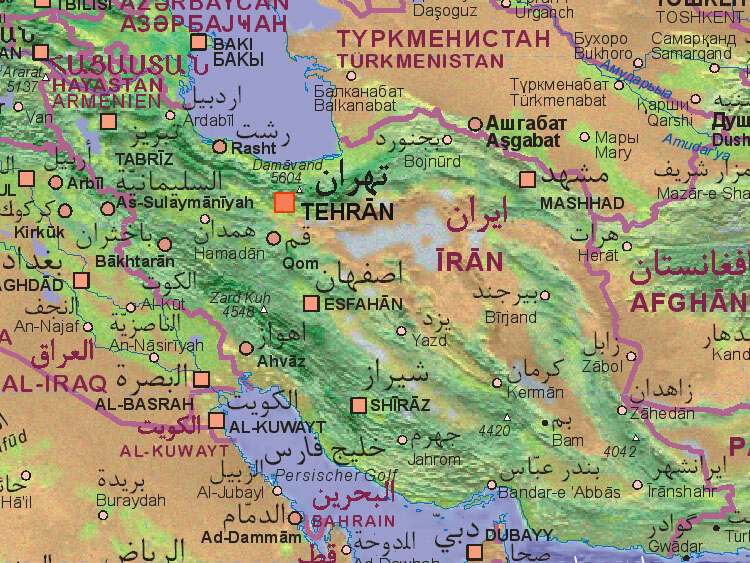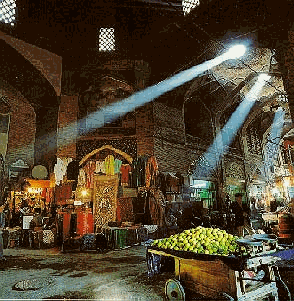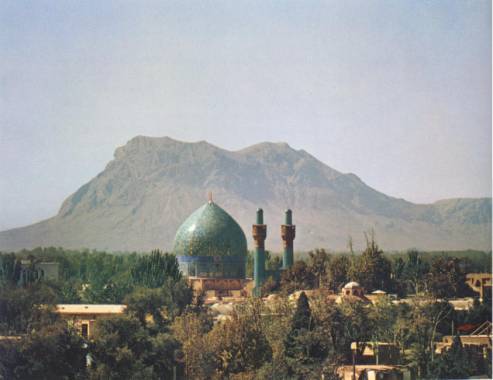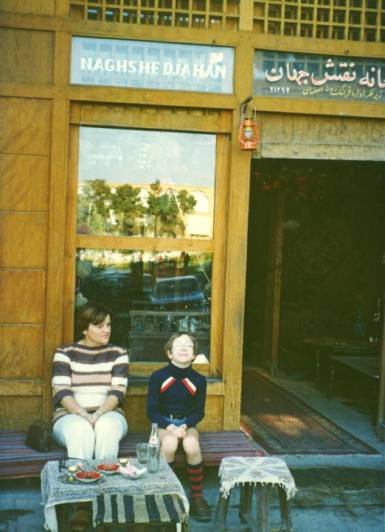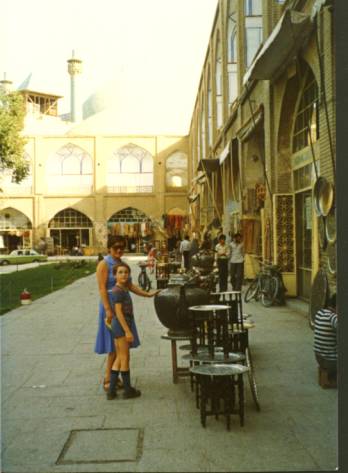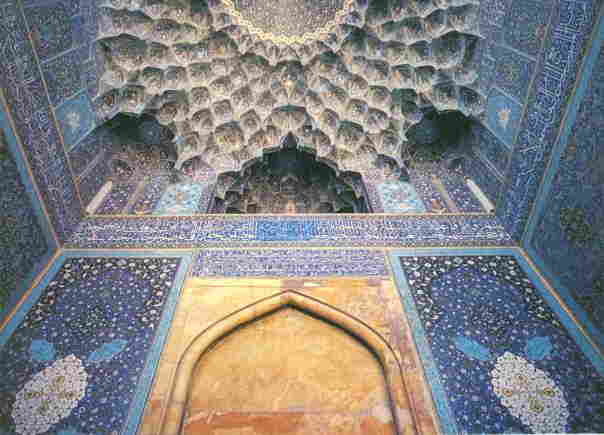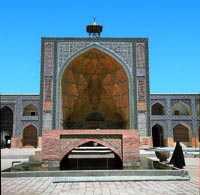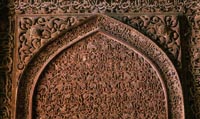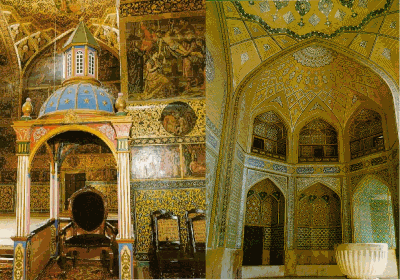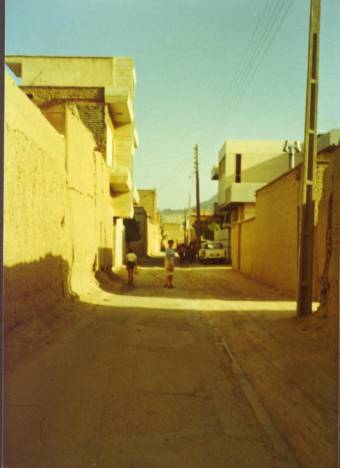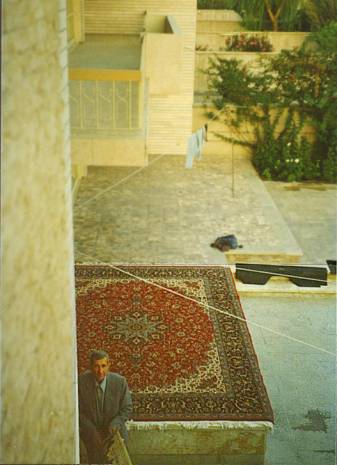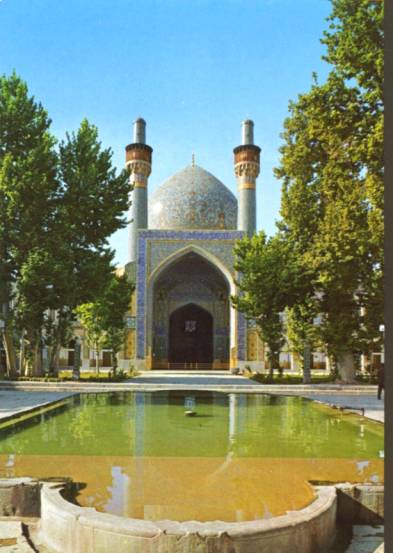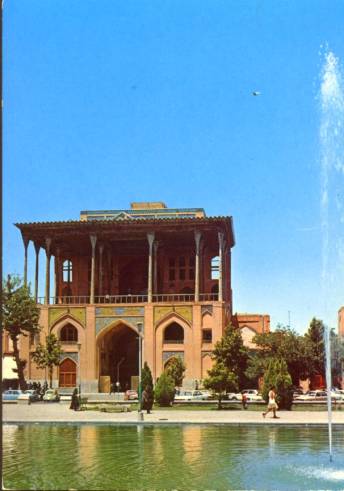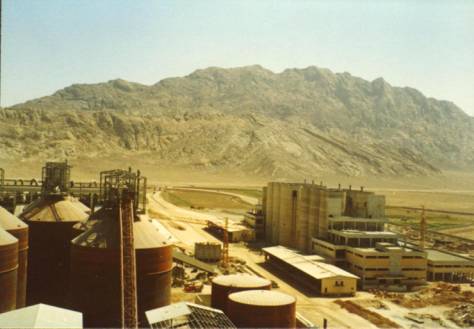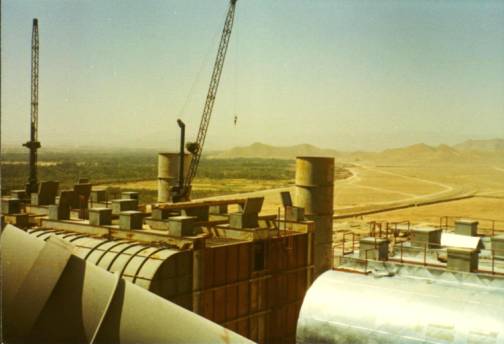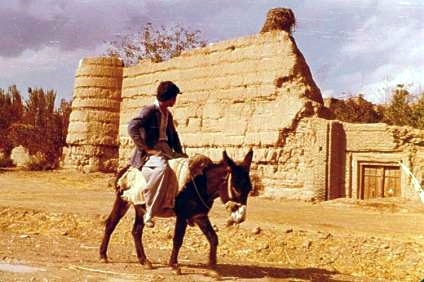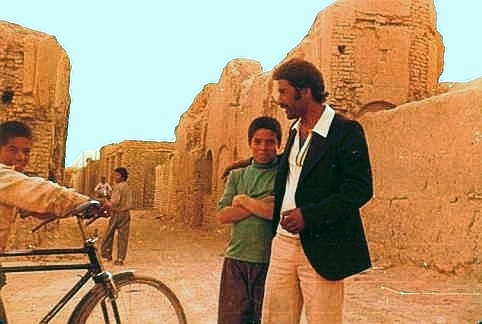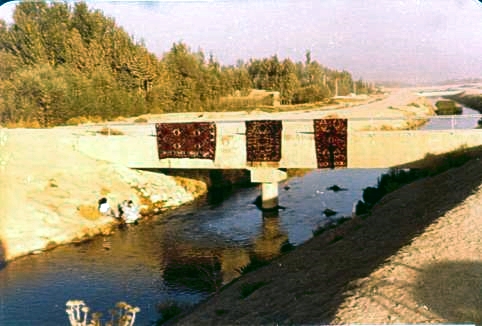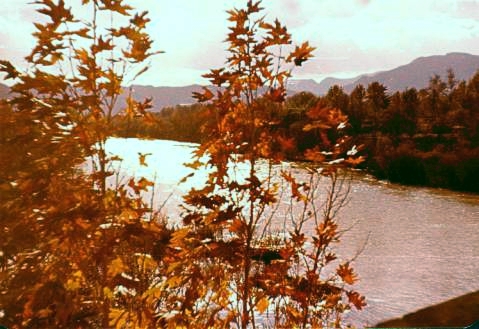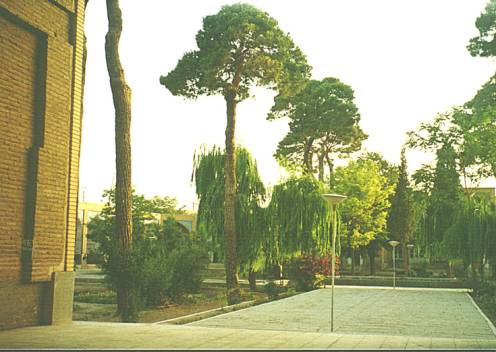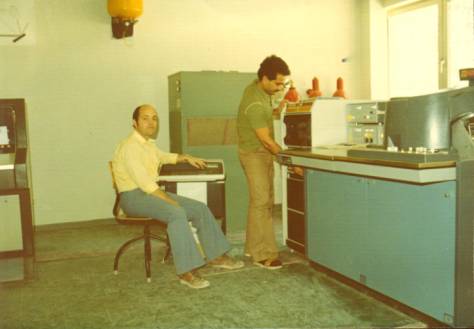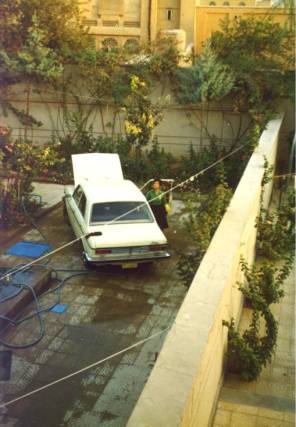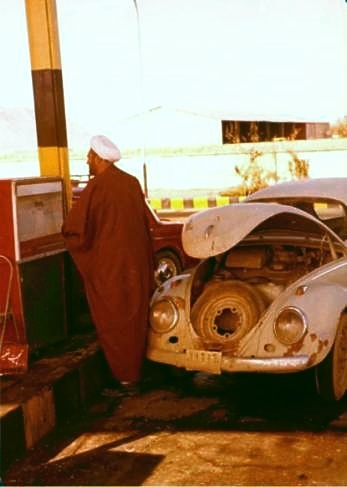After the complete laboratory equipment was already a half year on the plant site Aria in Persia, I flew to March 1978 with family and other colleague with their families to Isfahan, where we had to supervise and accomplish the assembly and start-up of the supplied technology. The first contact with Isfahan was overwhelming. In the infinite the silhouette of the mountain courses on the horizon seems to lose itself, which accompany the far deserts on the way from the airport to Isfahan. But then one stands suddenly before a large, open basin, in which the royal city rests. I was told the width of the city plant to domes, Minarets by the tremendous contrast surprised, which that sand and rock world with this enormous oasis, for this fruitful, form green basin, from that, and houses to stand out immediately and, while the leaves work of the large plane trees seems to cover itself like a shielding lattice over the buildings. It is not amazing that this city expands over a so considerable surface, because each family has its own house and nearly each house its garden into some also their own well had struck, so also our neighbour with name Chitsassha the one bazaar businessman was and with whom we quite well understood. From whatever direction one approaches the city, always one discovers first the towers of the mosques and the trees, which surround the houses, so that Isfahan resembles from a distance rather a forest as a city. One hour long carries us the way in the evening, brown loamy soil up-curved by the building site by monotonous desert area, which seems as created to still increase the surprise before the city of the blue resplendent domes becomes visible in the midst of the freshness promising oasis. One means, the curtain goes over a Theatre stage highly, because two bald mountains suddenly step before us apart and a garden Eden reveal themselves slowly our view. In the foreground meadows with large white blooms greet, it are meanwhile May, which in the contrast to the dusty monotonous of the desert like white snow the eye dazzles. Then a proper forest with Poplars, pastures, oaks and plane trees appears, until one discovers the many blue domes and the countless blue Minarets of Isfahan. It is a Hain and at the same time a city. But around such a miracle to bring such an city oasis in the middle of the desert into 1,400 meters height to flowering required it intensive irrigation, which became possible by the river Senda Rud (Zayande rud). From this river, which finds its origin in the 4,500 meters high mountains by melt waters, the water in numerous channels is derived. All irrigation canals of Isfahan and the surrounding area are supplied from it. The Persian urbanization differs in its nature thus fundamentally from the town planning common in Europe. The conception characteristic in Persia of space and area design, to which the phenomenon of the spatial into each other flow belongs, represents an extraordinary experience for me.
While one constantly is "in" something and crosses a consequence of spatial conditions, the secret of this urbanization becomes conscious. If I was evenly still surrounded by the warm atmosphere of the bazaar with its absorbed light and wonderful smells to selected herbs, then I stand suddenly, after crossing an exit, before the dazzling light surface of a far yard, which appears as speckled sometimes also from the leaves work of the trees; if one strikes then one the shady, but lanes did not consider in, one finally arrives at the edge of the large Meidan i Shah (king place), which is surrounded by trees and channels and from which walking people demands now crossing of this immeasurability reminding of a desert.
View from the king mosque of dome and Minarets of the Medresse (school) of Shah Sultan Husain. The tender elegance of the stretched Dome of outlines is accented 35 m high Minarets, which stand out from the close vegetation Isfahans still by the two strong, and in the midst of the freshness against the roughen rock background stand out promising oasis. This impression develops, because the proportions of the place, which is to be understood as a whole also as bazaar, compared with which more intimate dimensions in the rest of town structure appear excessive. Ring around this place the official buildings group themselves as accents, which monotonousness, which two floors interrupt and by the distance over the far place away at visual height win, the place circulating arcades.
Tea house at the Meidan i Shah (king place). My wife and my son with a glass of tea. During an expanded ceremony one prepares to the tea in Persia. The ceremony consisted of several marks in and pouring out the tea into a glass, whereby between in and pouring out with saucer and glass one rattled. To that tea were served also different Nuts on plates. Tea house at the Meidan i Shah (king place). My wife and my son with a glass of tea. During an expanded ceremony one prepares to the tea in Persia. The ceremony consisted of several marks in and pouring out the tea into a glass, whereby between in and pouring out with saucer and glass one rattled. To that tea were served also different Nuts on plates. One could smoke possibly still another water whistle. The bazaar with its artful entrance formed more than ever a polarizing element since within the city. Under the long, from vaulting meet customers and craftsmen considered gallery, where they are protected against the burning sun in the summer and the snowstorm and the downpours in the winter. If the bazaar on the one hand the point of main attraction for all guilds and guilds form, for craftsmen and dealers, who group themselves after conditions and differentiate from each other, then it must have the numerous religious people on the other hand also a number of civilian and sacral buildings like the caravanserais, the public baths (Hammams), the mosques and Medressen (schools), thereby for daily performing of the five
necessary prayers too far distances up to the next mosque to put back do not need, and the dealers, who often created their commodity from far away with caravans to the bazaar, on the spot to admission and accommodation find (in the today's days the car naturally as means of transport used). Thus the bazaar becomes the main passage of a locality, its backbone, on which all its vital functions concentrate. Migration at the arcades on the Meidan i Shah (king place), where many business sold their goods. Above all one could acquire artful copper plates and containers. The ornamentations in the artful plates were hit by the craftsmen with hammer and small chisel.
A business with a rich offer at plates and containers from copper, which are decorated art-fully with different ornamentations. In secondary rooms behind exhibition niches, which at that, for which customers released passage border, in backyards, which to the colouring of the threads from wool and silk, with which the carpets in the many small weaving mills are manufactured, prepares different colours from natural vegetable products. The carpet samples correspond to the much ornamentation, consisting of flower, illustrated at the mosques, animal and motives for writing, which are represented in the usually occurring colours, blue, red, green, pink ones and black.
I did not see ever such artful harmonious carpets in the world, as from the Persians. All other peoples the carpets wove, in the run of the years always to the Persian carpets than collecting main availed themselves. Also in this bazaar our neighbour possesses his sales niche, where he had issued the commodity to the sales. From him we bought different beautiful table set and carpets. We knew still in the time before the Imam Khomeini in November 1978 power took over different mosques without forced to visit. I had gotten used to myself, since I had to do much with the laboratory of the cement plant, with the laboratory leader Mr. Akbar Farsane and he us several times had accompanied and many references had given. It had shown us in the country, far outside from Isfahan, the production of bricks and clinker stones from loamy soil. In the following I would like to describe the specifically Persian type of the mosque more near. The Persian mosque possesses an inner court, which all around arcades seams; thus develop four internal fronts aligned to the centre, which are interrupted in each case by a Liwan. By such Liwan, which over-curved a large, from a half dome niche resembles, one arrives to that into one mosque resounding. It forms thus a gap, which lies neither completely inside nor completely outside and is particularly popular with the Persians. Since the Liwan covers represents he is spatially however final an architecturally important, plastic liaison vehicle. In this connection the mosaic and tile lining of the Persian mosques plays just as important role as the architectural structure, because it is like the skin over the building of bones and the musculature of an organism of unique importance.
My wife standing at the king mosque before the south liwan. The colourful ceramic(s) walls of the mosque consist 12 of thousands artful bricks and originate from that 12. Century refined technology of colour ceramic(s) and led to the greedy faience. After the piece of clay/tone was set during burning in the furnace under oxide steam, this steam on the colour glaze sets off and produces a metallic, Irish gloss, which was at that time very popular.
This high entrance portal (picture down) to the king mosque with its Stalactite net Shah Abbas the large one let 26.5 m place as the first completely. An inscription in accordance with existed one year later of the mosque only the foundation walls. The singular splendour of this portal represents the high point of the Persian building ornamental art. The red-brown marble in the foreground brings a warm clay/tone in the overall view.
The picture down places a Medresse (religion school), which was built between the years 1706 and 1714 integrated by the Shah Sultan Husain in a large building complex with a caravanserais and a bazaar. The Medresse has the beautiful name king mother, attached to it is a wonderful mosque with greener dome, which measures 37 m height up to the copper point.
The architectural decoration work, which was manufactured by bricks (tiles), was already in earliest time well-known. But the rhythmic ornamental art, which one reached by alternating size and placement of the bricks, begins its real play in the Islamic build-pounds only toward end 9. Century for the production of the brick is also fuel material necessary, and already in antique Persia like today wood rather goods in short supply were, but this element offers on the other hand some considerable advantages opposite oil or gas. The brick can be manufactured after firm and regular units, which simplifies the construction system substantially; it is easily transportable, in addition resistant and forms in connection with lime mortar a homogeneous, firm mass such as concrete. In addition the brick possesses sufficient elasticity, in order to get over earthquakes, which for the frequently afflicted area of the Iranian plateau of largest use is. Its porous structure is suitable itself finally also outstanding to isolation purposes, in high areas lain, in which one is particularly important which knows temperature differences up to 60 degrees C between summers and winters. We stated that all mosques are in the city Isfahan true piece of jewellery, and were just as beautifully and precisely decorated as the king mosque. Isfahan, the "sky-blue bead of Persian architecture", is from thoroughly aristocratic cut - sinless perceptible a style fully produced architecture of the powerful ones. Clearly inspired of monumental brightest place plants and not least of them developed for tremendously practical folders, the Roman forums, at the same time in Isfahan centre a representative palace front, religious collection places, a pedestrian precinct and a place of transhipment for silk and cotton. The existence of the directly neighbouring bazaar is before this background everything else as a coincidence; the consistent connection of culture and commerce was intended. At all the informal Reception of antique models is already in Islamic architecture during the early dynasty of the Omajjaden in 8 Century a completely natural component of routine concerning town construction. The functional inheritance of Roman cities disintegrating and the lively sassanidic decoration art are involved in particular in the Persian variant one "bark to Alliance" in, those their impression the few European travellers 18 Century did not miss. Antique thinking, literature and science had not remained always alive for actual "Islamic Renaissance" in the North African-Middle East core regions of the contentious prophet and religion founder Mohammed, "the praising", and it required therefore, in the clear difference to western Europe. A rebirth of the antique ones going far forbade itself however already in consideration of the Primate of the new religion of all alone. Thus in particular one loosened calligraphically independent-ends itself Arab writing art gradually the traditional picture world of the west off in the religious range. Regardless of the noticeable dependence on historical models, the "place of the king" is with its splendorous buildings and shady summerhouse courses certainly one likewise sovereigns like independent creation, which can offer besides surprising architectural intuitive feeling and remarkable precision in the execution of construction art-relating to crafts. Nevertheless the adjustment of the mosques prescribed by the Islam had to be agreed upon after Mecca with, diagonally a place structure aligned already found in addition elegantly, a nightmare for each architect.
As usual under freshly selected residence city everywhere in the world, the princely client wanted to as still as possible experience the completion of its personal dream. Like that regrettably the building speed of the durability of architecture was not evenly beneficial also in Isfahan. Foundationally lacking and the typical earth impacts of the extremely tremble-endangered region set for the sensitive buildings of splendour 17 Century likewise to like the inconsiderate plundering of Afghan mountain trunks. Thus the depressing realization reads toward end 20 Century that Isfahan, as jewel of central Persia and oriental dream of an allegedly golden age, expects to dangerous times.
There is still the Friday mosque the oldest ones in the city, also new hotels is true master buildings. For example the bridge Allahwerdi Chan over the river Senda Rud, has a length of 295 m and its three-part cover measures a height of altogether 13.75 m, about which the middle course is intended for the carts, while the pedestrians use the two sides of ways under the arcades. These bridges were restored later in the 90's, as my friend communicated Akbar Farsane to me.
Picture right, Chadschu Bridge Armed Forces the Shah Abbas II, reign from 1642 to 1667, to build left. It rests on a stone under body from the river height by means of contactors to be adjusted can, in order to supply the city and its garden plants with water. Picture left shows the promenade of the quarter with name Julfa beyond the river and by Armenians was to a large extent established. In the rule time of the Shah Abas I the large one, in the years 1587 to 1629, was granted to the Armenians for their services in the campaign against the Turks, the Persian citizenry and always and eternally promised them the right to freedom of religion. The Armenians were allowed to thus exercise their Christian faith and built gradually its churches those the mosques to resemble from the outside, however were by far not so art-fully decorated. We had gotten a dwelling in the proximity of this Armenian quarter made available by the company, lived in the lower dwelling in the ground floor, the first woman with two daughters of the owner of house. It was only rare with it, since it had its second wife in another city where his working premise was.
That quarter with name Julfa beyond the river was established by Armenians. The pictures right show architecture and artful mechanism in an Armenian church. On the pictures one sees a baptize basins and the Throne of the Preacher.
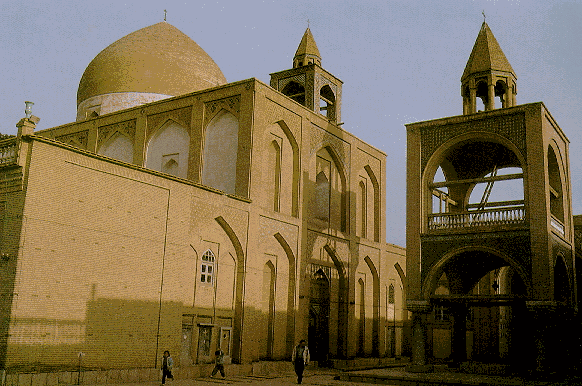
On the picture, which is made in the year 2003, one above sees no tears in the brick-work and this means that the churches are regularly reconditioned.
The Armenian churches from that 17. Century are still (2003) kept good, despite the strict Muslim regime. One was bent, because the sight of the road was simple (see picture left), not to visit these churches. However, was able to go to the curiosity past me not at the church. When we went then inside, we remained standing surprised and saw as beautiful and art-fully them on the inside arranged was. Picture right above shows a baptize basins from marble and the artful bricks, inside the church, with which the walls up to roof dome are equipped. The manufacturing process of the bricks, from the Persians to have taken over, similarly the bricks with which the Persians their mosques have decorated from the inside and outside. Motives, represented on the bricks, different were natural. Also in this area it gives were sometimes not yet so strong to sometimes develop for earthquakes, which, however tears in the brick-work can.
The picture left shows my wife in the road in which we lived. Each house with garden is surrounded by a high wall and can refuse so strange looking. The Persians is many handling-friendlier and more tolerant than the Arab peoples. As one sees in the picture was it late on the day there the shade long is. When it became for me time the hairdresser go could I actually only in the Armenian quarter a halfway reasonable hairdresser to find, before it began my hair to cut, the shears before over a flame disinfected. I was obvious to the first foreigner, who ever with him the hair had let cut. After that the hair was cut wanted I to know which it cost it refused for cutting to be paid and I had to bring it money with reproduction to it from me to take on. Our neighbour family, living in the house to the left side, was like already before mentions an independent bazaar businessman and has two daughters and a son. The oldest daughter is married and my wife after the confinement a daughter to an attendance had invited with a physician. My wife was pleasantly surprised as it outside before the gate in the wall stood and was let in, her saw the beauty of the garden and the house. When she then finally came with the door into the room of the lucky mother, she was astonished at the splendid mechanism of the room and lay the mother like a princess in her bed.
View of the adjoining house of the bazaar Businessman. The neighbour is to be seen left down in the picture. It had even outside in the backyard a valuable carpet to lie. We were invited quite often from the neighbour family to the dte drinking and could admire the many artful carpets on the soil as well as artful Chinese vases. The houses had all flowing water, i.e. the connection at an underground laid water pipeline as with us in Germany. This water was so cleanly that I without consider it drink could, my wife and my son however was able rather the water from bottles, which one could buy in beverage business. Which in Isfahan was unsatisfactory, was the supply of food, fresh fruit and fresh vegetable was rare from good quality, one had many conditions to always search over to some extent rightfully to come? In the summer there were enormous amount tomatoes and water melons to juice was converted and cooled for the consumption offered, which at temperatures to the 50° C recreating was. Freshness diligence one could only in a business with a Indian in the centre of the city buy and in to aunt a Emma shop directly in the road around the corner, canned goods and butter from Germany procure.
My wife had cooked always good and vitamin rich meals. Over in the centre of the city to arrive we used together a passenger car placed by the company, or we placed ourselves at the road to a taxi driven past came, to which coincidentally into our direction drove, presupposed it were still places free. The taxis did not have radio and could thus not be ordered, them drove by the area around customers to constantly gather, the taxi were not expensive, because the fuel was cheap. As bread only flat bread was gotten with the many bakers in the major roads too, the baking personnel was all day long at baking and had because it none at home had before the business on the sidewalk to stay overnight, because were migratory workers. Other migratory workers stood early in the morning at certain collecting points in main streets of where it with penalties to their jobs were driven. We against it were gathered individually by a bus rented by the company and driven to the plant site and who was too late finished with its breakfast or which had overslept time, had to follow with the taxi. The travel went over one hour directly through meagre desert into southern direction, at bald mountains along up to the plant site and against the evening again into the city was gone back. The children of the German families were likewise gathered by a minibus and brought to the German school.
On the left of the Medresse with names Chahar brook, which are located in the old quarter and possess a marvellous garden. The building is reflected secretly water basin again. Each evening after the work was spoken still until late into the night for cooling after the hot day on the balcony, at the back of the house with view on the garden and oil lamp on the table with tea comfortably about the happening of the past daily. If we drove my wife, because them all day long at home were and also times no desire had to cooking, or us the food had gone out, into the city to a restaurant in a beautiful Persian hotel for diner. On such a day during a meal we met a Turkish officer with family, he told us that it was stationed here and trained Persian officers because they could not be trained in the USA, to educate had. Us much also up that many young Persian in the restaurant looked and as we copied with our cutlery were busy, because that it was apparent important for those. There was generally between the Persian in the USA was trained and that in the homeland trained was rivalries and struggles for power. Also between engineers there were these fights. The American military, which at present the Shah rule was stationed in Isfahan, was shifted to Viet Nam war here and had made themselves unpopular with the Persian. This unpopularity was produced by the fact that the American soldiers with their dollar of everything bought up which it only wars could and heavily loaded with food over the road went, where most Persians was poor nevertheless and it could not afford. A thorn in the eye was also that many young women of the Europeans and Americans ran in the middle in Bikini by day on the road, which is not permitted in a Moslem led country because of the custom. The Americans were also us opposite the Europeans not friendly.
One of the most beautiful hotels in Isfahan with name Shah Abas, picture right, the garden with a watercourse, which at being called day donates freshness. Picture left, the front side of the hotel. My Persian friend Akbar Farsane had us on one Friday, which Islamic Sunday, with its car also into the mountains to a place driven where it its brickyard had and showed, was hand formed, dried us like the clinker stones and stacked to a heap in a furnace in the free one and by a firing with charcoals was burned. On the way back around midday we came in a village, where at the village place some women in a giant pot, which was set up over an open fire, cooked soup. To cost we promptly invited the soup and to express us over the taste, what I also did, because the soup was enormously sharp from taste by to spice-add. In the country one saw also many sheep, which differentiate with respect to the nature thereby of our sheep the fact that they hang the fat in the back between the paws under the tail have which looked very amusing. The European sheep against it, do not have their fat distributed over the whole body thereby them cold weather in the winter to project, the Persian sheep need this. On such Fridays (thus Sundays) we went swimming also much in the local swimming pool and could there also somewhat to the lunch get, in the sun browned ourselves to leave were very dangerous because of the 1,400 m height, by UV irradiation, even if one had sat all day long under a sun screen were one heavily burned and for us Europeans thus caution required. Also the possibility existed to be in the German club, where one could meet German compatriots of other companies around its experiences to exchange and could play the children with one another. One evening we invited from the club manager to a large celebration, where a whole pig at a skewer over an open fire in the club garden was grilled, thank God was a high wall around the club area, because pig meat was actually because of the religion in Persia forbidden however for us Europeans a delicate-eats. There were also beer and other alcoholic beverages, which were likewise forbidden.
Left on the picture the building with name Ali Ghapoo at the Meidan i-Shah place. This building is still older as the mosques and served the ruler than stand over for its honouring Parade to hold. I could not experience the winter in Isfahan unfortunately, since we had to leave the country for the time being under the seizure of power the Islam aforementioned from the Imam Khomeini. The temperatures in the months after September were after sunset down 20 degrees C however had already rained it since our arrival at the end of March not yet. Generally the rain and snow storm come only in the months Decembers until February, whereby the temperatures arrive only at short notice after narrations at 0 degrees C. The Shah had abolished the large-landed property and had divided the country among the small farmers, but they were not subsidized in the beginning, because the Shah spent many with the oil made money for the military, above all to have the Americans for the annoyance of the Persian people most money taken the money and some influential Persians as well as the family of the Shahs likewise, because otherwise Khomeini would not have digs had power to take over. I noticed already early, when I was confronted with Persian personnel on the plant site, as strained the situation was. Since I had to install and in enterprise take the technology, for the regulation of the quality of the product, as well as for the mechanism of the chemical laboratory was responsible, I had because the laboratory before production started to be already finished had to do as the first with the Persian personnel.
The new plant consisted clinkers, which were supplied together by a row material storage of two production lines, with a capacity each of 3,000 t/d. Samples were already brought by these raw materials taken to the analysis in the chemical laboratory, the available analyzed values of these samples for the calibration to the Roentgen fluorescence plant begun and thus were operational the plant to fast analyzing of the samples for production. Plant site with view of the mountains and about 100 km of the city Isfahan removes. On the left of down the clinkers shelters and on the right of down the cement silos with the building of the cement mills. The row material storage are also filled iron ore and gypsum by crushers cut up limestone, clay, sand, whereby the limestone and clay in each case in a mixing process, i.e. evenly in layers over the length of the gravel bed to a mountain stacked. Before the crusher operated in to go was allowed had a sheep is sacrificed, which was accomplished by a priest.
A pneumatic pipe system transported limestone or clay/tone samples in regular time periods in cartouches in the laboratory. The first line taken thereafter, begun with the raw meal mills, gradually over the homogenizing silos, rotating furnace up to the clinker silos in operated already briefly. In this process the continuous Roentgen fluorescence equipment was for the measurement of the composition of the raw meal, i.e. CaO, SiO2, Al2O3 and Fe2O3. After the raw meal mills however before the homogenizing silos. The data resulting from this are transmitted, evaluated to the large computer in the control post and given possible corrections as placing values to the respective proportion Belt weigher under the respective pre bunker before the mills. The pre bunker is filled with limestone, clay, sand and iron ore in each case. It is promoted from the flour stream, by air, from the raw meal mills to the homogenizing silos of a sampling plant continuously a sample branched and automatically prepares to the Roentgen fluorescence plant given up. Additionally, during start-up and continual run time of the mills, samples become manual for analyzing and examination of the continuous x-ray unit in the flour stream, for which laboratory taken, which are then analyzed with the x-ray unit in the laboratory.
These samples were taken by the simple personnel coming from the surrounding villages in layer service and brought to the laboratory. One of the laboratory personnel was a farmer, could with the yield of its yard not get along and had as a Laboratory worker still besides to earn, this man with a meeting with one of our mechanics in the enterprise during it a sample not get had, excited into the laboratory had actually come and caught at to raving over the fact that the mentioned mechanic carried two golden indications about which an indication a cross was and the other one was an Islamic Amulet, this an offence of the Islamic religion and had is repaired. I have it thereupon told that the Christianity with the Islam distorted with each other by Abraham is and thus the two indications do not do pain each other, with this explanation he agreed. Picture left, view into the distance of watered plants and mountains. In the foreground the Electron filters of the raw meal mills.
The same farmer had asked me, why I do not speak Persian, whereupon I answered with the fact that Persian a heavy language is and one must be longer time in Persia around it to learn, since I do not only work in Persia but everywhere in the world around come and in this connection not all languages learn can I only to English is limited and in addition I could already read and write all numbers. With this explanation it was then finally content. Further there were under the higher personnel struggles for power and rivalries over the question who where had studied and which may occupy higher positions. Some Persian at that time by their parents on schools in the USA or Europe skilfully, others again could only in Teheran study to carry out because their parents were not so richly around itself a study abroad. At each daily beginning, already stood for the tea in the laboratory on my table and had that in all peace to only drink up before to the work we went. On the picture left we sees the rotating furnace with its typical satellites radiators at the discharge and behind it the clinkers silos. This admission was taken by the heat exchanger into approximately 50 meters height. These radiators became in the later years, by which use of shorter furnaces does not use no more.
A young farmer rides on a donkey at a fortress of a former large basic owner along. In the country at the river along in corridor width, on the left and on the right the river of approximately three to five kilometres, where by a thought out irrigation system centuries already the agriculture in the region Isfahan existed, it was to before the Second World War, which controls country only from large basic owners. The last Shah had divided gradually the country under the rural population. The great land owners lived in fortresses which one still as ruins here and there recognize can, the current farmer live as before, in villages closely together, where no fastened roads, road lighting or drains is present. If one goes in such a way through the roads, one means to have a ruin before itself.
We drove also times with darkness into step speed by the roads of such a village and determined a mysterious emptiness and peace, which sometimes by an open gate in the wall where light outside radiated, suddenly was interrupted and lives announced. All housing units were directly together lining up built and outward with irregular arbitrary walls surrounded, the whole thing with the close roads were from a distance hardly as village to be recognized. View of a road of a village in the country. One sees the inhabitants to be reacted as normally and friendly. The material with this thing was built consists of, in the sun, for dried hand formed loam stones, which were bricked one on the other with a loam straw mixture as mortar-similar bonding agent, which was cleaned from the outside and inside so developed walls afterwards with the same bonding agent.
Picture left shows a channel with flowing water at a village, where women hung their carpets up and at the Railing bridges for drying. Sometimes we met places, where pumps were assigned, which brought the water on a higher level, these pumps dated from the years before the Second World War, which were made of Cologne by the company Deutz and totter still perfectly before itself. In Septembers unrests in the villages and cities caught 1978 because of the forthcoming change of power of the Moslems rule and chamfering time beginning, also on the building site under the Persian personnel about nothing else were spoken and discussed. At the beginning of Octobers of the same yearly, after the chamfering time Ramadan, had concerned the political situation in Persia at a depression, on points of main traffic in the city was suddenly tanks into position gone and today on mornings was allowed the Persians, on instruction of the Mullahs, no more in the public with stranger to operate, only strictly the religious people followed the instruction, this applied above all for the Americans and disbelieving ones.
Picture right, the river Senda Rud outside of Isfahan, on the banks sumptuous green and many brown-red like also yellow tree sheets, the sky easily cloudily. My friend Akbar Farsane had procured tickets for us for the bus journey after Teheran, because we could not remain longer because of civil war danger in Persia. The air traffic between Isfahan and Teheran was until further notice suspended. I had myself before the departure still another certification of the director of cement plant given, because the building site line wanted me yet does not leave leaves, because I need a justification for the company at home. Few weeks later the plant site was evacuated and all colleagues to have been left Persia. The first line of the new cement plant was actually nearly finished and already in enterprise, later the Persians finished the second line and taken in enterprise with exception of the large computer and its many programs. In the city and in completely Persia there were ever more frequently demonstrations with foreigner hostile slogans. The bus journey after Teheran was not cumbersome at all; the bus was clean and for is enough for journey prepared.
I, my wife and my son were the only foreigners in the bus, we by the common travelled Persians were friendly and forestalling treated, I had even the impression the fact that they looked forward also times strangers to the journey to meet to be able, because normally fly the foreigner or in so a case become the strangers with chartered airplanes gone on a trip therefore was the bus journey most surely because nobody from official side this assumed. Early in the morning over 8:00 clock we drove off and, after a travel of more than 400 km with many between rest times at typically eastern restaurants, late in the evening around 10:00 clock in the midst of Teheran at a bus station had arrived. Since in Teheran around 22:00 clock a curfew had been imposed, I had to look for still another hotel and in the darkness if possible a taxi snaps to continue us for a super elevated price to the hotel drove, where we arrived still before the closing hour. On the journey on the way the bus had just still by the holy city Gome where a straight demonstration ran, the common travelled Persians guessed us during the passage to duck to be noticeable over not unnecessarily. The plant site lay only times more down, like me my friend Farsane wrote and the name Aria of the cement plant had been renamed in Zepahan Cement CO. My friend Farsane comes to Germany in 1982, because it there for the time being politically did not hold out.
A garden plant, affectionately maintained, in (picture right) a building complex, where mosque, Medresse and yard arcades are enclosed. It was a misery that we had to leave the beautiful city Isfahan and also the friendship with our neighbours were abruptly interrupted, because it could not have no more as pious creditors a Muslim with us contact.
Picture left, my friend Akbar Farsane at the analytical device and I on the chair in the automatic laboratory, which was still very primitive in the time, because the sample preparation was semi automatically that is called the sample material became still by hand into a simple mill given up and the grinding material in a small flat aluminium container under the press a tablet pressed, which was put by hand again into the chamber of the analytical device.
Picture left points the daughter of the neighbour with name Parvin Chitsass when auto washing, it had told my wife that if it would not have been with me, she would have tried me to take in.
Picture right down, my son on a ruin of a fortress built before Islamizing Iran, with prospect on the watered level at the river close of the city Isfahan. Picture left down, a Mullah (priest) with its Volkswagen beetle at the gas station. The Volkswagen is in Iran a rare piece, because there were predominantly English Auto marks, which were built under license.
